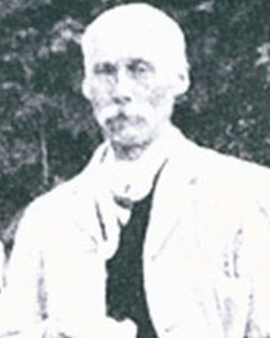Albert Goodwin was a British landscape painter who had a great passion for watercolour painting throughout his life. Goodwin was born in 1845 as one of nine children. He grew up in Maidstone, the capital of the English county of Kent. Albert finished his school career with the Abitur. Although his artistic talent was already evident in his early childhood, Goodwin initially learned a trade, like his father, who was a master builder. In his free time he painted; preferably with watercolors. Already at the age of 15, his first paintings were exhibited.
After his education he devoted himself completely to his great passion, painting. He moved to London and studied at the Royal Academy of Arts. Two of his lecturers, Ford Madox Brown and Arthur Hughes, become Goodwin's biggest supporters. Both painters were members of the Pre-Raphaelite Brotherhood, an association of English painters who shaped the art style of Pre-Raphaelism in the middle of the 19th century. This style stood for the faithful reproduction of nature. Their paintings were marked with the abbreviation "PRB". Goodwin, too, could identify with the aims of the brotherhood. His paintings were strongly influenced by the idea of brotherhood. During his studies Goodwin met the well-known London art critic John Ruskin. Ruskin was blown away by the extraordinary talent of the young Goodwin. He invites the painter on a journey through Europe. During this journey Albert Goodwin made countless landscape sketches, which he later transformed into detailed watercolours.
In the following years Goodwin travels again and again through Europe. Visited the most diverse landscapes and drew in nature. Traveling developed into his second passion, which inspired him greatly. He is one of the most prolific artists in the country and produced over 800 paintings during his lifetime. He later joined the Royal Watercolour Society, or "RWS" for short, which was founded in London in 1804. Different from the pre-Raphaelite brotherhood, the members do not develop their own artistic style. It was their concern to create more appreciation for watercolour paintings. At exhibitions at the Royal Academy they felt disadvantaged compared to the artists who exhibited classical oil paintings. For this reason, from 1805 onwards they organised their own exhibitions for watercolour artists, in which Albert Goodwin also regularly took part. The exhibitions were a great success. Year by year, more visitors came and the sales revenues for watercolour and watercolour paintings increased significantly. This was a great success, which the painters had to thank the Royal Watercolour Society. Goodwin painted until old age.
×





.jpg)
.jpg)
.jpg)
.jpg)
.jpg)
.jpg)
.jpg)
.jpg)
.jpg)
.jpg)
.jpg)
.jpg)
_-_(MeisterDrucke-907372).jpg)
_-_(MeisterDrucke-907372).jpg)
.jpg)
.jpg)
_-_(MeisterDrucke-1488528).jpg)
_-_(MeisterDrucke-1488528).jpg)
.jpg)
.jpg)
.jpg)
.jpg)
.jpg)
.jpg)
.jpg)
.jpg)
.jpg)
.jpg)
.jpg)
.jpg)
_-_(MeisterDrucke-230469).jpg)
_-_(MeisterDrucke-230469).jpg)
.jpg)
.jpg)
.jpg)
.jpg)
_-_(MeisterDrucke-558522).jpg)
_-_(MeisterDrucke-558522).jpg)
 - (MeisterDrucke-637245).jpg)
 - (MeisterDrucke-637245).jpg)
.jpg)
.jpg)
.jpg)
.jpg)
_-_(MeisterDrucke-1511793).jpg)
_-_(MeisterDrucke-1511793).jpg)
.jpg)
.jpg)
.jpg)
.jpg)
 - (MeisterDrucke-222219).jpg)
 - (MeisterDrucke-222219).jpg)
.jpg)
.jpg)
_-_(MeisterDrucke-1512494).jpg)
_-_(MeisterDrucke-1512494).jpg)
.jpg)
.jpg)
.jpg)
.jpg)
.jpg)
.jpg)
.jpg)
.jpg)
_-_(MeisterDrucke-1512395).jpg)
_-_(MeisterDrucke-1512395).jpg)
_-_(MeisterDrucke-1514268).jpg)
_-_(MeisterDrucke-1514268).jpg)
.jpg)
.jpg)
_-_(MeisterDrucke-1466042).jpg)
_-_(MeisterDrucke-1466042).jpg)
.jpg)
.jpg)
.jpg)
.jpg)
.jpg)
.jpg)
.jpg)
.jpg)
_-_(MeisterDrucke-1125073).jpg)
_-_(MeisterDrucke-1125073).jpg)
.jpg)
.jpg)
_-_(MeisterDrucke-1488499).jpg)
_-_(MeisterDrucke-1488499).jpg)
.jpg)
.jpg)
_-_(MeisterDrucke-1125067).jpg)
_-_(MeisterDrucke-1125067).jpg)
.jpg)
.jpg)
_-_(MeisterDrucke-1488689).jpg)
_-_(MeisterDrucke-1488689).jpg)
.jpg)
.jpg)
.jpg)
.jpg)
.jpg)
.jpg)
.jpg)
.jpg)
.jpg)
.jpg)
.jpg)
.jpg)
.jpg)
.jpg)
.jpg)
.jpg)
.jpg)
.jpg)
.jpg)
.jpg)
.jpg)
.jpg)
.jpg)
.jpg)
.jpg)
.jpg)
.jpg)
.jpg)
.jpg)
.jpg)
.jpg)
.jpg)
_-_(MeisterDrucke-599206).jpg)
_-_(MeisterDrucke-599206).jpg)
.jpg)
.jpg)
) - (MeisterDrucke-257159).jpg)
) - (MeisterDrucke-257159).jpg)
.jpg)
.jpg)
_-_(MeisterDrucke-907319).jpg)
_-_(MeisterDrucke-907319).jpg)
.jpg)
.jpg)
_-_(MeisterDrucke-1132517).jpg)
_-_(MeisterDrucke-1132517).jpg)
_-_(MeisterDrucke-1488812).jpg)
_-_(MeisterDrucke-1488812).jpg)
.jpg)
.jpg)
.jpg)
.jpg)
.jpg)
.jpg)
.jpg)
.jpg)
.jpg)
.jpg)
.jpg)
.jpg)
.jpg)
.jpg)
.jpg)
.jpg)
.jpg)
.jpg)
_-_(MeisterDrucke-907375).jpg)
_-_(MeisterDrucke-907375).jpg)
.jpg)
.jpg)
.jpg)
.jpg)
.jpg)
.jpg)
_-_(MeisterDrucke-1488775).jpg)
_-_(MeisterDrucke-1488775).jpg)
_-_(MeisterDrucke-1125109).jpg)
_-_(MeisterDrucke-1125109).jpg)
.jpg)
.jpg)
.jpg)
.jpg)
.jpg)
.jpg)
.jpg)
.jpg)
.jpg)
.jpg)
.jpg)
.jpg)
_-_(MeisterDrucke-1112502).jpg)
_-_(MeisterDrucke-1112502).jpg)
_-_(MeisterDrucke-1488684).jpg)
_-_(MeisterDrucke-1488684).jpg)
.jpg)
.jpg)
_-_(MeisterDrucke-1512400).jpg)
_-_(MeisterDrucke-1512400).jpg)
_-_(MeisterDrucke-907639).jpg)
_-_(MeisterDrucke-907639).jpg)
.jpg)
.jpg)
_-_(MeisterDrucke-1511792).jpg)
_-_(MeisterDrucke-1511792).jpg)
_-_(MeisterDrucke-1129103).jpg)
_-_(MeisterDrucke-1129103).jpg)






